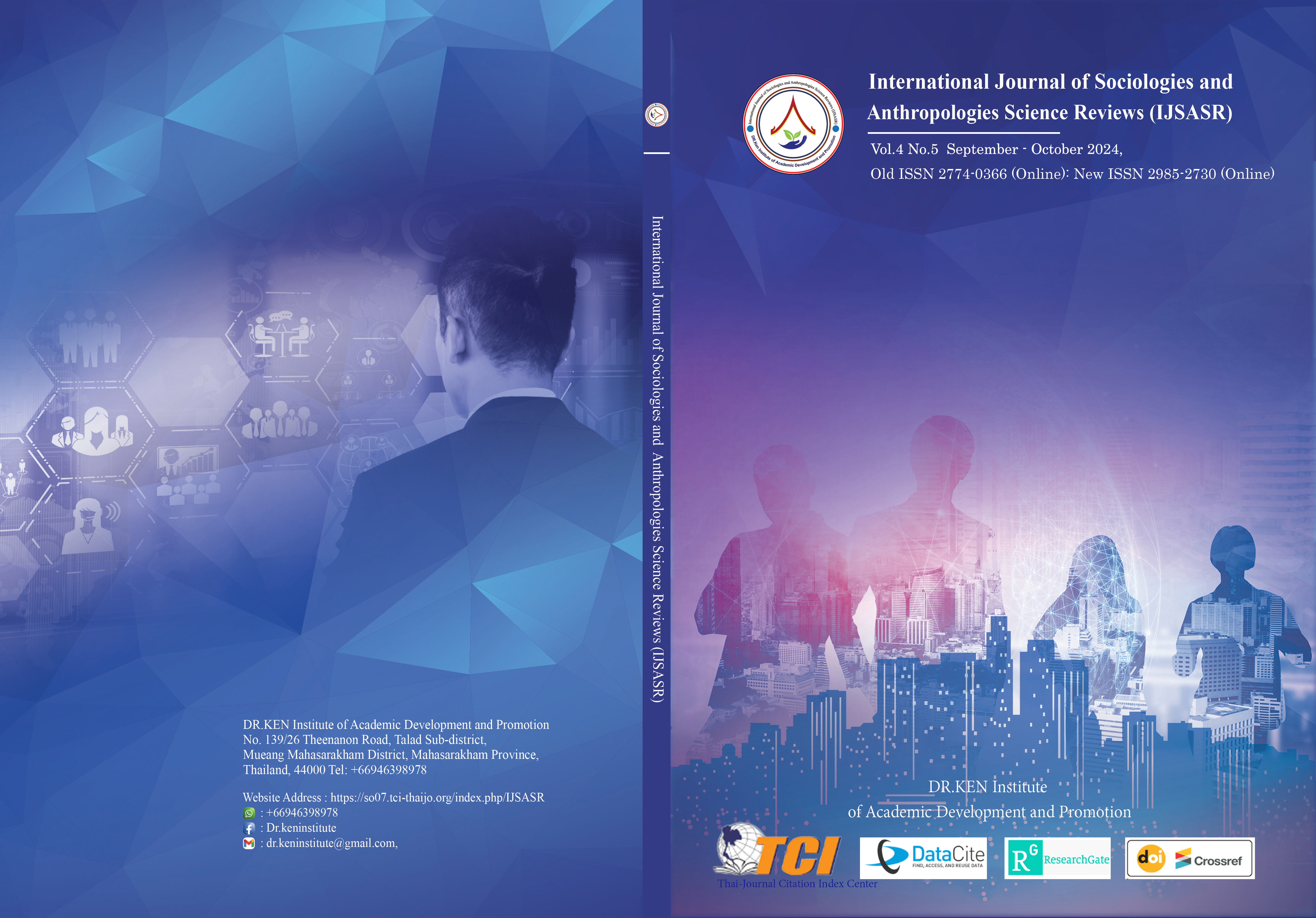The Singing Techniques of Traditional Chinese Yu Opera in Sociological and Anthropological Perspectives
Main Article Content
Abstract
Background and Aims: Traditional Chinese Yu Opera, a culturally significant art form, embodies unique singing techniques that offer rich insights into the social and cultural dimensions of China. This research aims to investigate the singing techniques of traditional Chinese Yu Opera from sociological and anthropological perspectives.
Materials and Methods: The study utilized a mixed-methods approach, combining qualitative analysis, ethnographic observation, and expert interviews. Extensive literature reviews provided a theoretical foundation, while fieldwork included observing performances and conducting interviews with Yu Opera artists and cultural experts. This comprehensive methodological framework aimed to capture the nuances of singing techniques and their socio-cultural implications.
Results: The research findings highlight that Yu Opera's singing techniques are not only artistic expressions but also potent cultural symbols that reflect and influence social structures and values. Detailed analyses of performances, particularly the opera "Mulan", revealed how these techniques convey cultural narratives and facilitate social interaction, aligning with sociological theories of cultural capital and anthropological views on cultural transmission.
Conclusion: This study underscores the importance of Yu Opera's singing techniques as cultural texts that extend beyond mere performance, serving as vehicles for social cohesion and cultural continuity. The findings advocate for enhanced educational programs and interdisciplinary research to preserve and understand traditional arts like Yu Opera, ensuring their relevance in contemporary society.
Article Details

This work is licensed under a Creative Commons Attribution-NonCommercial-NoDerivatives 4.0 International License.
Copyright on any article in the International Journal of Sociologies and Anthropologies Science Reviews is retained by the author(s) under the under the Creative Commons Attribution-NonCommercial-NoDerivatives 4.0 International License. Permission to use text, content, images, etc. of publication. Any user to read, download, copy, distribute, print, search, or link to the full texts of articles, crawl them for indexing, pass them as data to software, or use them for any other lawful purpose. But do not use it for commercial use or with the intent to benefit any business.

References
Alexander, V.D. (2020). Sociology of the arts: Exploring fine and popular forms. John Wiley & Sons.
Chan, C.S.C. (2018). Sustainability of indigenous folk tales, music, and cultural heritage through innovation. Journal of Cultural Heritage Management and Sustainable Development, 8(3), 342-361. https://doi.org/10.1108/JCHMSD-06-2017-0044
Chen, W., & Woramitmaitree, N. (2024). Vocal Techniques Literacy in Huai Opera for School-Based Education in Shanghai Municipality, China. International Journal of Education and Literacy Studies, 12(1), 252-259. https://doi.org/10.7575/aiac.ijels.v.12n.1p.252
Feng, W. (2020). Intercultural Aesthetics in Traditional Chinese Theatre. Springer International Publishing. https://doi.org/10.1007/978-3-030-40635-6
Gordon, K.H. (2023). Jing-kun and the Hundred Operas: Revisiting the Categorization of Chinese Theatre. Journal of the Society for Asian Humanities, 54, 136-155.
Haili, M. (2016). Urban politics and cultural capital: The case of Chinese Opera. Routledge. https://doi.org/10.4324/9781315548739
Lam, J.S. (2022). Kunqu: A classical opera of twenty-first-century China. Hong Kong University Press. https://doi.org/10.5790/hongkong/9789888754328.001.0001
Lawson, F.R.S. (2020). Hidden musicality in Chinese Xiangsheng: a response to the call for interdisciplinary research in studying speech and song. Humanities and Social Sciences Communications, 7(1), 1-9. https://doi.org/10.1057/s41599-020-0528-y
Lee, H. (2016). Chinese feelings: Notes on a ritual theory of emotion. The Wenshan Review of Literature and Culture, 9(2), 1-37.
Liu, Q., & Chonpairot, J. (2024). Exploring the Narrative and Aesthetic Aspects of Huanglong Opera in Nong'an County Jilin Province China. International Journal of Sociologies and Anthropologies Science Reviews, 4(2), 279-288. https://doi.org/10.60027/ijsasr.2024.3930
Lo, W.H. (2017). Traditional opera and young people: Cantonese opera as personal development. International Journal of Adolescence and Youth, 22(2), 238-249. https://doi.org/10.1080/02673843.2016.1163503
Lu, F., & Sornyai, P. (2024). Exploring Organology and Learning Techniques of Dongxiao Chinese Folk Musical Instruments in Shandong Province. International Journal of Sociologies and Anthropologies Science Reviews, 4(2), 53-66. https://doi.org/10.60027/ijsasr.2024.3751
Norton, B., & Matsumoto, N. (Eds.). (2018). Music as heritage: Historical and ethnographic perspectives. Routledge. https://doi.org/10.4324/9781315393865
Qiu, L., Chuangprakhon, S., & Phulaiyaw, A. (2023). An investigation of developing and inheritance of Qin'an Xiaoqu in Gansu Province China: Developing and inheritance of Qin'an Xiaoqu in China. International Journal of Curriculum and Instruction, 15(2), 867-876.
Rao, N.Y. (2017). Chinese Opera Percussion from Model Opera to Tan Dun. China and the West: Music, Representation, and Reception, 163-185. https://doi.org/10.2307/j.ctt1qv5n9n.11
Snelson, J. (2016). How to Enjoy Opera. Bloomsbury Publishing.
Susam-Sarajeva, Ş. (2016). Translation and music: Changing perspectives, frameworks, and significance. In Translation and music (pp. 187-200). Routledge. https://doi.org/10.4324/9781315538204-3
Tsioulakis, I., & Hytönen-Ng, E. (2016). Musicians and their audiences: Performance, speech, and mediation. Taylor & Francis. https://doi.org/10.4324/9781315597010
Volpp, S. (2020). Worldly stage: theatricality in seventeenth-century China (Vol. 267). BRILL.
Wright, R. (2021). The Routledge Handbook to Sociology of Music Education. G. Johansen, P. A. Kanellopoulos, & P. Schmidt (Eds.). London: Routledge.
Wu, G. (2022). An Anthropological Inquiry Into Confucianism: Ritual, Emotion, and Rational Principle. Rowman & Littlefield.
Wu, K. (2023). Cultural Confluence: The Impact of Traditional and Modern Synergies in Chinese Juvenile Musical Theater. International Journal of Education and Humanities, 11(2), 192-199. https://doi.org/10.54097/ijeh.v11i2.13825
Yan, A., & Yifei, L. (Eds.). (2019). Contemporary Anthropologies of the Arts in China. Cambridge Scholars Publishing.
Yao, L., Sensai, P., & Junkate, K. (2023). Nurturing cultural engagement and learning among youth through Jingyun Dagu traditional Chinese folk songs in Tianjin Municipality: Cultural engagement and learning among youth. International Journal of Curriculum and Instruction, 15(3), 1845-1859.
Yao, S. (2021). Cultural Expression and Subjectivity of Chinese Peasants. Routledge. https://doi.org/10.4324/9781003189800
Yu, N., & Jia, D. (2016). Metaphor in culture: life is a show in Chinese. Cognitive Linguistics, 27(2), 147-180. https://doi.org/10.1515/cog-2015-0080
Zeng, G., & Maneewattana, C. (2024). Study on the Changes of Singing Behavior of Huaihua Shanghe Yang Opera from the Perspective of Cultural Ecology. Proceeding National & International Conference. 16 (1), 348-356.
Zhang, Y. (2024). Cultural Roots and Artistic Growth: Traditional Elements and Innovation in Modern Yue Opera Productions. Studies in Art and Architecture, 3(1), 21-25. https://doi.org/10.56397/SAA.2024.03.03
Zhang, Y., Chaiyason, N., & Phimprajun, R. (2024). Musical Literacy and Education: A Historical Analysis of Huaibang Opera Development in Henan Province, China. International Journal of Education and Literacy Studies, 12(2), 101-110. https://doi.org/10.7575/aiac.ijels.v.12n.1p.96






